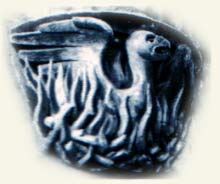Yet
another poem from the Exeter
Book. The first 380 lines of The Phoenix are a free paraphrase
of the fourth-century Latin Carmen de Ave Phoenice usually ascribed
to Lactantius. No
specific source is known for the second part of the poem.

The image of the Phoenix, as it is developed in the first part, is used as an allegorical representation of both Christ and the blessed in the second part. Its main emphasis lies on Judgement. But different to Judgement Day I and II or Christ III, for example, the poet uses a more positive approach. He concentrates on the righteous, from their deeds while still alive, via their resurrection and judgement, to their final reward in the heavenly kingdom.
The
style of the poem suggests a disciple of Cynewulf as its author, 'but probably
not Cynewulf himself' .
'And though the English poet...drew with creative skill upon the compositional
formulas of traditional vernacular poetry and thus thoroughly naturalized
the eastern legend, he also experimented creatively under the influence of
the classical Latin rhetoric of Lactantius, and to his repertory of English
rhetorical devices added occasional internal rhyme and assonance and concluded
his poem with ten lines of macaronic (mixed Latin and vernacular) verse.'
.
'And though the English poet...drew with creative skill upon the compositional
formulas of traditional vernacular poetry and thus thoroughly naturalized
the eastern legend, he also experimented creatively under the influence of
the classical Latin rhetoric of Lactantius, and to his repertory of English
rhetorical devices added occasional internal rhyme and assonance and concluded
his poem with ten lines of macaronic (mixed Latin and vernacular) verse.'